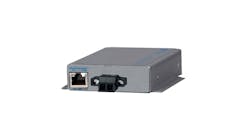Easing access to field device data, now and in the future
By now, most process plant personnel have certainly heard of big data, but many have yet to be convinced of its value. The problem isn't the capability of field instruments and other devices for creating big data and transmitting it to host systems. Rather, many see the issue as how this can be done in a simple and cost-effective way, such that the value of the data exceeds the cost of gathering and preparing it for analysis. Field device manufacturers are responding to these concerns by adapting standards and embedding them in their instruments.
For example, many instruments support the two-way, digital HART communication protocol, which is superimposed on a traditional 4-20 mA analog current loop to enable sending and receiving data with a calibration device or host system. This formerly stranded and now accessed data includes diagnostic, calibration, maintenance, process and other information, greatly increasing configuration ease and providing added operational process insights.
This provides flexibility to continue using existing analog loops for real-time control, while delivering extended data via HART to support data-driven decisions in a facility. WirelessHART provides another option to easily connect with instruments—especially those installed in remote, hazardous, and/or hard-to-access areas.
While HART and WirelessHART data can provide immense benefits to a wide range of host systems and applications—such as maintenance management, asset information and health management, inventory control and enterprise resource planning systems—process plant personnel often don't take full advantage.
Automation systems regularly use flow, pressure, temperature, level and other process data to monitor and control processes, but these systems often discard status and diagnostic data. By ignoring this supporting data, process plant personnel miss opportunities to optimize, simplify and safeguard plant operations.
Intelligent plant analysis systems can ingest this data, enabling process plants and facilities to increase their ratio of proactive to reactive maintenance, thus reducing unplanned downtime and avoiding equipment and human safety hazards. For example, instead of waiting to get a high-level alarm, process data can be used to give an alert when conditions are detected that would lead to this type of issue.
Diagnostic data integrated into host systems can be analyzed to provide advance warning of instrument failure, or troubleshooting insights in the event of failure. Because calibration and nameplate information are also internally stored in each instrument, tracking and managing assets is easier throughout plant lifecycles.
Cybersecurity and other potential issues
While the scenarios above outline benefits of using data collected from field instruments, many process plant personnel are rightly concerned about the risks associated with open access to data. Another complication is standardizing the way collected data supplied by instruments from various vendors is stored and viewed.
To address these and other issues, tools such as FDI have been developed. FDI provides safe and secure ways to integrate field device data to host systems, and a common approach for managing the integration of information associated with intelligent field devices for configuration, commissioning, diagnostics, calibration and other tasks.
FDI was designed for openness, including inclusion of new networking media and automation protocols, as well as incorporating innovative technologies. EtherNet/IP, ISA100 Wireless, and Modbus TCP are all supported within FDI technology.
While the technologies discussed above are being used today to improve access to field instrument data, the future will demand even more advanced solutions to address the vast amounts of data required by cloud-based analytics. The cloud efficiently engages the large amount of computing resources required for advanced analytics tools, such as machine learning and artificial intelligence, but these and other applications need secure access to big data for maximum performance. Fortunately, solutions are forthcoming for these and other use cases.
Look ahead
In the future, new field devices may provide native support for the process automation device integration model (PA-DIM), a vendor-independent information model with a structured hierarchy. PA-DIM provides standardized data access for devices, with all parameters defined in IEC 61987 CDD with Semantic ID, ensuring each parameter can be easily reused between different software tools and protocols. Information models such as PA-DIM now enable like parameters to be compared regardless of protocols or supplier in machine-readable form for analytics.
Another technology of interest to many is Ethernet-APL, which combines the best of existing digital communication technologies with consideration for specific industrial needs, such as extended cable lengths, suitability for hazardous areas and robust noise immunity. It's poised to become the new open standard for connecting process automation and instrumentation, using a familiar two-wire installation approach with a long reach of up to 1,000 meters between network switches, along with an additional 200 meters to each field device.
The HART-IP protocol operating over Ethernet-APL flattens the industrial control network, enabling many higher-level systems to easily access field device information.
Like all networks, Ethernet-APL doesn't work in isolation, but must instead be paired with communication protocols and information models to provide a complete solution. One possibility combines Ethernet-APL with HART-IP and PA-DIM. HART-IP is a 21st century evolution of the familiar and widely implemented HART protocol, operating on Ethernet. It features built-in cybersecurity to ensure credentials are in place, and it's designed to move large amounts of data quickly.
While this type of solution will work well with traditional applications, such as connecting field instruments to a distributed control system (DCS) and other on-premises platforms, it can also be used to connect field devices directly to the cloud. Bypassing the DCS in this manner greatly reduces cost because no added input points are required, and the extensive efforts required to add input points to this type of real-time control system are eliminated.
New field devices will natively support direct cloud communications, allowing process plant personnel to quickly and inexpensively add new points of measurement for ingestion by cloud-based analytics and other applications. This increases the value proposition by making it easier to collect and analyze data, while providing actionable information to those who need it, wherever they're located. The cloud is a natural progression for these types of applications because it provides near-infinite scalability of computing resources, along with the required secure and worldwide two-way access.
Regarding the future, the question on the minds of many is what new process automation communication technologies will become dominant, and which will fall by the wayside. One factor that may weigh heavily in the outcome is ease-of-use. For example, Ethernet-APL extends upon many of the familiar principles of operation now used in Ethernet applications, making its adoption easier for end users. In a similar fashion, HART-IP is built on familiar HART and WirelessHART technologies, which eases implementations.
Whatever the outcome, standards development organizations, like the FieldComm Group, will continue to support end users in their quest to make better use of field device data.
About the author
Ted Masters is the president and CEO of the FieldComm Group. He has held leadership roles in a wide variety of technology companies supporting the process industry for more than 30 years. Masters has experience in managing the growth and delivery of products, software, and service solutions to industrial markets. His career has been centered around the conversion of operational data into actionable intelligence, and helping users make better decisions to capture value by integration into business systems and processes. Masters holds a BSEE degree from the University of Kentucky.

Leaders relevant to this article:





